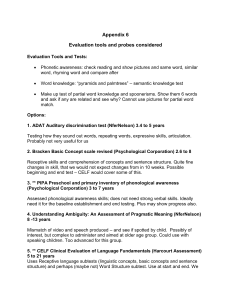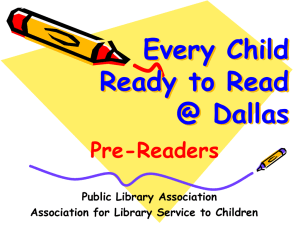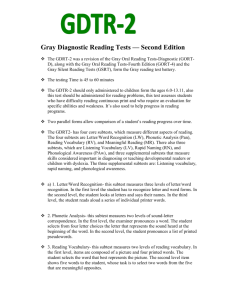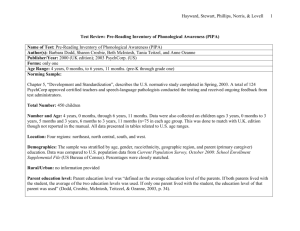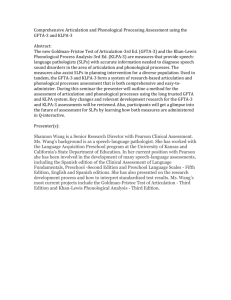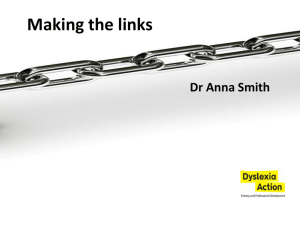AAG-Pre-Reading Inve..
advertisement
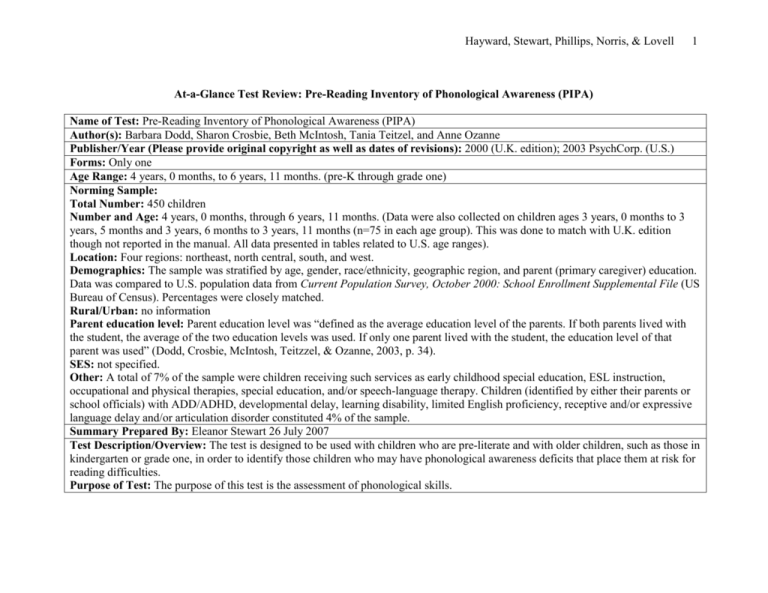
Hayward, Stewart, Phillips, Norris, & Lovell 1 At-a-Glance Test Review: Pre-Reading Inventory of Phonological Awareness (PIPA) Name of Test: Pre-Reading Inventory of Phonological Awareness (PIPA) Author(s): Barbara Dodd, Sharon Crosbie, Beth McIntosh, Tania Teitzel, and Anne Ozanne Publisher/Year (Please provide original copyright as well as dates of revisions): 2000 (U.K. edition); 2003 PsychCorp. (U.S.) Forms: Only one Age Range: 4 years, 0 months, to 6 years, 11 months. (pre-K through grade one) Norming Sample: Total Number: 450 children Number and Age: 4 years, 0 months, through 6 years, 11 months. (Data were also collected on children ages 3 years, 0 months to 3 years, 5 months and 3 years, 6 months to 3 years, 11 months (n=75 in each age group). This was done to match with U.K. edition though not reported in the manual. All data presented in tables related to U.S. age ranges). Location: Four regions: northeast, north central, south, and west. Demographics: The sample was stratified by age, gender, race/ethnicity, geographic region, and parent (primary caregiver) education. Data was compared to U.S. population data from Current Population Survey, October 2000: School Enrollment Supplemental File (US Bureau of Census). Percentages were closely matched. Rural/Urban: no information Parent education level: Parent education level was “defined as the average education level of the parents. If both parents lived with the student, the average of the two education levels was used. If only one parent lived with the student, the education level of that parent was used” (Dodd, Crosbie, McIntosh, Teitzzel, & Ozanne, 2003, p. 34). SES: not specified. Other: A total of 7% of the sample were children receiving such services as early childhood special education, ESL instruction, occupational and physical therapies, special education, and/or speech-language therapy. Children (identified by either their parents or school officials) with ADD/ADHD, developmental delay, learning disability, limited English proficiency, receptive and/or expressive language delay and/or articulation disorder constituted 4% of the sample. Summary Prepared By: Eleanor Stewart 26 July 2007 Test Description/Overview: The test is designed to be used with children who are pre-literate and with older children, such as those in kindergarten or grade one, in order to identify those children who may have phonological awareness deficits that place them at risk for reading difficulties. Purpose of Test: The purpose of this test is the assessment of phonological skills. Hayward, Stewart, Phillips, Norris, & Lovell 2 Theoretical Model: Chapter 4 provides the rationale and scope for the PIPA. In this chapter, the authors highlight the direct link made between phonological awareness and reading, identifying this as “well established”, referencing the NICHHD report (2000) summarizing the empirical research. They state, “A review of research by the National Reading Panel, commissioned by the National Institute of Child Health and Human Development (2000), has determined that phonological awareness is one of the best school-entry predictors of future reading and that phonological awareness training improves the reading of young students significantly more than instruction that pays no attention to phonological awareness” (Dodd, et. al., 2003, p. 25). They further point to federal initiatives (U.S.) taken in light of the findings with a view to highlighting the importance of identifying the children who struggle early in their academic careers. Thus, they justify the need for “ reliable and quick assessments of phonological awareness, such as the PIPA, for preliterate students” (p. 25). In a section, “Development and Components of Phonological Awareness”, phonological awareness is defined and its significance is supported by references to the literature. Following Hoien, Lundberg, Stanovich, and Bjaalid (1995, copy in file), the authors state that words can be subdivided into smaller units by: 1. syllabic awareness, 2. intra-syllabic awareness, and 3. phonemic awareness. The PIPA is designed to follow these three levels “by investigating the ability to detect, isolate, or manipulate the units at the specified level” (outlined in Table 4.1, Dodd, et. al., 2003). Comment: The reference list is not very long at 38 entries. Compared to other tests reviewed, the rationale and review of the literature is quite brief. However, the brevity is in keeping with the entire manual which overall is parsimonious. Areas Tested: The PIPA has 6 subtests: 1. rhyme awareness 2. syllable segmentation 3. alliteration awareness 4. sound isolation 5. sound segmentation 6. letter-sound knowledge Who Can Administer: Teachers, speech-language pathologists, reading specialists, special educators, and “diagnosticians may administer the test. Administration Time: Total time to administer the test is 25 to 30 minutes, with each subtest estimated to take four to five minutes. Test Administration (General and Subtests): The test is administered individually. Each subtest has a demonstration item as well as trials. Start points, discontinue rules and a repetition rule are stated in the manual, in the stimulus book, and on the record form. The directions for recording and scoring responses are described in the text along with guidelines in table form (Table 2.2, Dodd, et. al., Hayward, Stewart, Phillips, Norris, & Lovell 3 2003) for each subtest. Scores are 1-correct, 0-incorrect, and 0-NR for no response. A raw score is tabulated from the sum of items passed. Guidelines are specific to each subtest. The Record Form has a small section at the end of each subtest that is labeled “Item Analysis Table”. This table is intended to be used to identify strengths and weaknesses and/or to identify strategies the child used. Test Interpretation: Chapter 3 provides “Interpretation”. In this chapter, the authors present brief information about raw scores, percentile ranges, and introduce a section, “Categories of Achievement”, which describes percentile ranges with interpretation (see the Standardization section of this review which follows). This chapter also includes three case studies for children, age 4 years, 9 months; 6 years, 0 months; and 6 years, 10 months. Standardization: Percentiles “Categories of Achievement” divide the percentile score ranges as follows: 1. Emerging/below basic: 0 to 29th percentile 2. Basic: 30th to 69th percentile 3. Proficient: 70th to 99th percentile Reliability: Internal consistency of items: Range from .82 for Rhyme Awareness and Alliteration Awareness to .96 for Letter-Sound Knowledge. N=75 for each age group. Test-retest: 75 children. Test-retest in 7-28 days, with mean of 13 days. Same examiner “in the majority of cases.” Results, reported for each subtest were: Rhyme awareness =.80, Syllable segmentation =.67, Alliteration =.83, Sound isolation =.94, Sound segmentation =.83, and Letter-sound knowledge =.97. Inter-rater: Two scorers (with same qualifications as the test administrators”) independently scored 40 randomly selected standardization tests chosen before testing, audiotaped administration. Results: moderate to high. Range .82 (Syllable Segmentation) to .86 (Letter-Sound Knowledge). Other: Validity: Content: Chapter 4, previously outlined, presented the research foundation for phonological awareness skills. Criterion Prediction Validity: PIPA was compared to Early Reading Diagnostic Assessment, Second Edition (ERDA, Second Edition). 96 children were tested in a counterbalanced order of test administration, which was carried out by the same examiner with an interval of 0 to 47 days (x=8 days) between test administrations. At kindergarten level: 1. moderate to high correlations for kindergarteners. Similarity of task and of construct, e.g., Rhyming was highly correlated (.71), 2. low correlation on PIPA Syllable Segmentation and ERDA Phonemes because the former measures phonemic while the latter measures syllabic awareness (low at .31), 3. moderate correlations for subtests of phonemic awareness and ERDA Phonemes (range from .55 to .69), Hayward, Stewart, Phillips, Norris, & Lovell 4 4. moderate to high correlation for Letter-Sound Knowledge and seven ERDA subtests requiring decoding letters (range .42 to .81), and 5. the highest correlation was found between the Letter-Sound Knowledge subtest and ERDA Letter Recognition (.81). Classification consistency: Using the percentile scores from the PIPA and ERDA, comparisons were made in the classifications based on percentile ranges. For kindergarten children, the exact classification consistency ranged from 40% to 63% and those differing by only one category ranged from 90% to 100%. For grade one children, those classified exactly the same way ranged from 23% to 48% and from 90% to 98% for those who differed by only one category. Construct Identification Validity: Construct Identification Validity: Using data from the standardization sample (n=450), intercorrelations among subtests were consistent with expectations. The Letter-Sound Knowledge subtest showed .78 for Alliteration Awareness and .78 for Sound Isolation. Weaker correlations were demonstrated where “subtests measure different levels of phonological units” (.42 for Syllable and Sound Segmentation). Differential Item Functioning: not provided Other: Summary/Conclusions/Observations: PIPA has an easy to read manual, not too long but with all information clearly presented. The subtests are explained and the tasks make sense. Clinicians should have no difficulty using this test in assessment. I think that it would be beneficial for further work to be done to strengthen the psychometric properties. The test is adequate as is, but would be even better with studies demonstrating accuracy (sensitivity and specificity). I would have more confidence if this information was available. Clinical/Diagnostic Usefulness: I think that the potential examiners should be skilled in the area of phonological awareness to make good use of the test and to be able to discern the range of responses possible. As well, being familiar with speech and language difficulties would be an asset. References Dodd, B., Crosbie, S., McIntosh, B., Teitzzel, T., & Ozanne, A. (2003). Pre-reading inventory of phonological awareness. San Antonio, TX: PyschCorp. National Institute of Child Health and Human Development (2000). Report of the National Reading Panel. Teaching children to read: An evidence-based assessment of the scientific research literature on reading and its implications for reading instruction (NIH Publication No. 00-4769). Washington, DC: U.S. Government Printing Office. Hayward, Stewart, Phillips, Norris, & Lovell 5 U.S. Bureau of the Census. (2000). Current Population Survey, October 2000: School Enrollment Supplemental File [CD-ROM]. Washington, DC: U.S. Bureau of the Census (Producer/Distributor). To cite this document: Hayward, D. V., Stewart, G. E., Phillips, L. M., Norris, S. P., & Lovell, M. A. (2008). At-a-glance test review: Pre-reading inventory of phonological awareness (PIPA). Language, Phonological Awareness, and Reading Test Directory (pp. 1-5). Edmonton, AB: Canadian Centre for Research on Literacy. Retrieved [insert date] from http://www.uofaweb.ualberta.ca/elementaryed/ccrl.cfm
